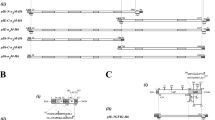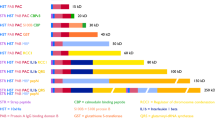Abstract
Human growth hormone (HGH), somatotropin, is a protein consisting of 191 amino acids with a molecular weight of ∼22,000. It is essential for linear growth and its application in the treatment of hypopituitary dwarfism is well established1–3. Growth hormone may also be effective in the treatment of other disorders including bone fractures, burns and bleeding ulcers4. Because growth hormone is species specific, human cadavers have previously been the only source of HGH. Moreover, the standard purification of pituitary-derived HGH does not provide a homogeneous product, but rather a mixture of native HGH and modified forms and fragments of HGH, each of which may have different physiological roles5. The expression of HGH in Escherichia coli using recombinant DNA technology6 provides an inexhaustible source of a single eukaryotic protein. The bacterially synthesized HGH, produced from E. coli, is methionyl-HGH (Met-somatotropin), the extra methionine arising from the AUG start codon inserted at the beginning of the gene. This cloned product has now been purified to homogeneity and its biological properties examined. For pituitary and bacterially synthesized HGH, specific activities as determined by radioimmunoassay are comparable.
This is a preview of subscription content, access via your institution
Access options
Subscribe to this journal
Receive 51 print issues and online access
$199.00 per year
only $3.90 per issue
Buy this article
- Purchase on Springer Link
- Instant access to full article PDF
Prices may be subject to local taxes which are calculated during checkout
Similar content being viewed by others
References
Raben, M. S. J. clin. Endocr. 18, 901–904 (1958).
Goodman, H. G., Grumbach, M. M. & Kaplan, S. L. New Engl. J. Med. 278, 57–68 (1968).
Escamilla, R. F. in Hormonal Proteins and Peptides Vol. 3 (ed. Li, C. H.) 147–190 (Academic, London, 1975).
Raiti, S. (ed.) Proc. NIAMDD Symp. Publ. No. 74–612 (1973).
Lewis, U. J. et al. Recent Prog. Horm. Res. 36, 477–508 (1980).
Goeddel, D. V. et al. Nature 281, 544–548 (1979).
Burgess, R. R. & Jendrisak, J. J. Biochemistry 14, 4634–4638 (1975).
Laemmli, U. K. Nature 227, 680–685 (1970).
Li, C. H. in Hormonal Proteins and Peptides Vol. 3 (ed. Li, C. H.) 1–40 (Academic, London, 1975).
Clark, B. F. C. & Marcker, K. A. J. molec. Biol. 17, 394 (1966).
Cappechi, M. R. Proc. natn. Acad. Sci. U.S.A. 55, 1517–1524 (1966).
Adams, J. M. J. molec. Biol. 33, 571–589 (1968).
Li, C. H. in Hormonal Proteins and Peptides Vol. 4 (ed. Li, C. H.) 1–41 (Academic, London, 1977).
Stebbing, N. et al. Recombinant DNA tech. Bull. 3, 12–21 (1980).
Thorngren, K. G. & Hansson, L. I. Acta endocr., Copenh. 75, 653–668, 76, 35–52 (1974).
Hughes, P. C. R. & Tanner, J. M. J. Anat. 106, 349–370 (1970).
Holmstroem, B. & Fholenhag, K. J. clin. Endocr. Metab. 40, 856–862 (1975).
Lewis, U. J., Dunn, J. T., Bonewald, L. F., Seavey, B. K. & VanderLaan, W. P. J. biol. Chem. 253, 2679–2687 (1978).
Hirs, C. W. Meth. Enzym. 11, 59–62 (1967).
Gurd, F. R. N. Meth. Enzym. 11, 532–541 (1967).
Fullmer, C. S. & Wasserman, R. H. J. biol. Chem. 254, 7208–7212 (1979).
Author information
Authors and Affiliations
Rights and permissions
About this article
Cite this article
Olson, K., Fenno, J., Lin, N. et al. Purified human growth hormone from E. coli is biologically active. Nature 293, 408–411 (1981). https://doi.org/10.1038/293408a0
Received:
Accepted:
Issue Date:
DOI: https://doi.org/10.1038/293408a0
This article is cited by
-
Resistance exercise stress: theoretical mechanisms for growth hormone processing and release from the anterior pituitary somatotroph
European Journal of Applied Physiology (2023)
-
Use of Ubp1 protease analog to produce recombinant human growth hormone in Escherichia coli
Microbial Cell Factories (2014)
-
Characterization and optimization of ArtinM lectin expression in Escherichia coli
BMC Biotechnology (2012)
-
Verification of the final anion exchange chromatography in the r-hGH manufacturing process
Biotechnology and Bioprocess Engineering (2010)
-
A Brief Overview of Transgenic Farm Animals
Veterinary Research Communications (2007)
Comments
By submitting a comment you agree to abide by our Terms and Community Guidelines. If you find something abusive or that does not comply with our terms or guidelines please flag it as inappropriate.



